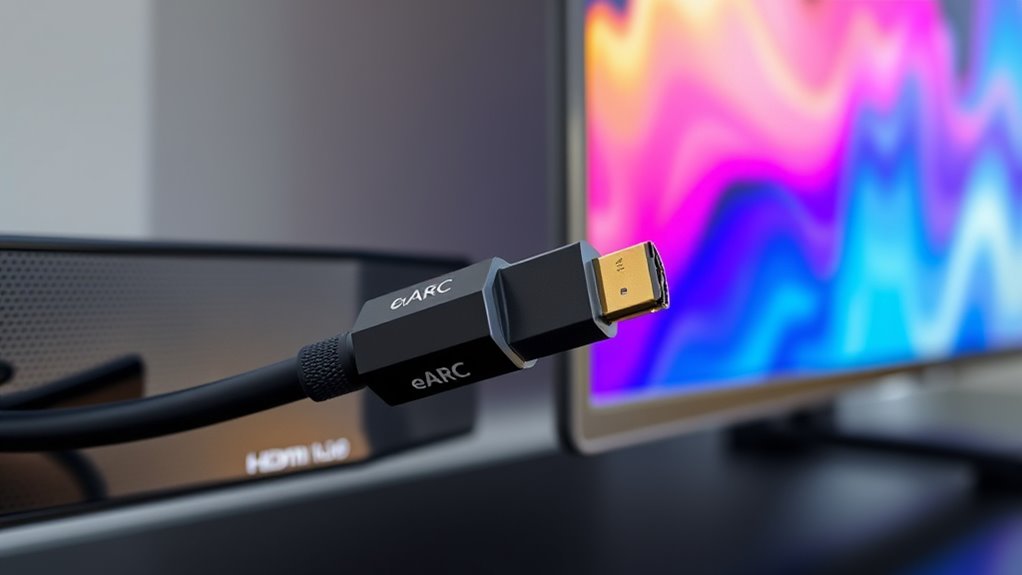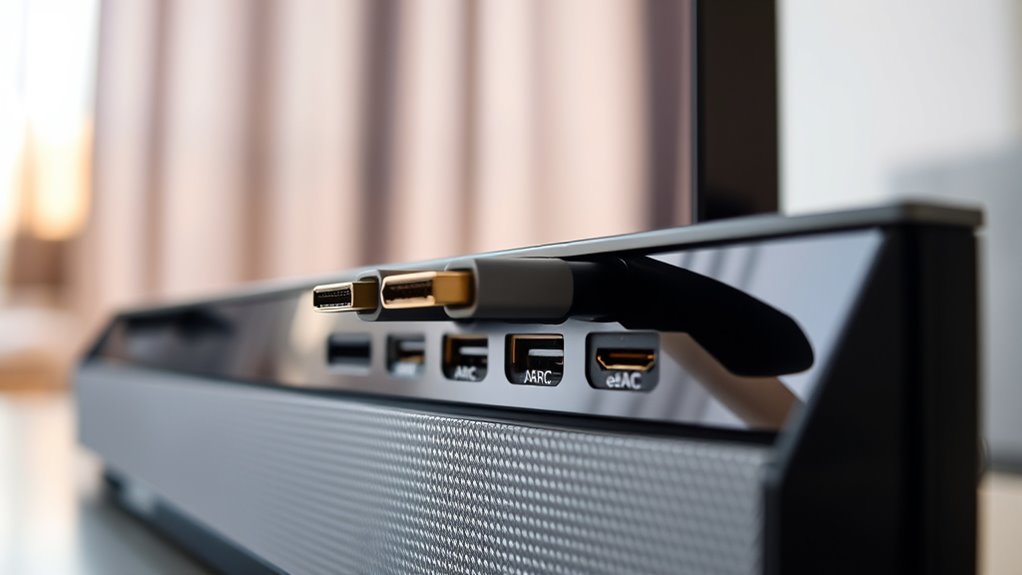HDMI ARC lets you send audio from your TV to a sound system using standard HDMI cables, supporting common formats like Dolby Digital, but it has limited bandwidth for high-quality sound. eARC offers faster data transfer, supports uncompressed audio like Dolby Atmos and DTS:X, and works with higher-quality sound systems for a more immersive experience. To fully enjoy these benefits, devices need to be eARC-compatible. Exploring the details can help you optimize your home audio setup.
Key Takeaways
- HDMI ARC handles common audio formats but struggles with advanced formats like Dolby Atmos and DTS:X, which eARC supports uncompressed.
- eARC offers higher bandwidth for uncompressed, high-quality audio, providing immersive, object-based sound experiences unavailable with ARC.
- HDMI ARC is compatible with most devices but may face handshake issues; eARC uses more robust protocols for reliable, seamless connections.
- Both require HDMI 2.1 support for full functionality, with eARC needing newer equipment and high-speed cables for optimal performance.
- eARC is ideal for high-fidelity, modern home theater setups, ensuring better sound quality and future-proof compatibility.

Have you ever wondered what sets HDMI ARC and eARC apart? While both are designed to simplify your home entertainment setup, understanding their differences can help you make better choices for your devices. One key aspect that distinguishes them is their support for various audio formats. HDMI ARC was introduced years ago, and it handles common audio formats like Dolby Digital and DTS. However, it struggles with newer, higher-quality formats such as Dolby Atmos or DTS:X, which require more bandwidth. eARC, on the other hand, was developed later to support these advanced audio formats. This means if you want immersive, object-based audio, eARC becomes essential because it can transmit uncompressed audio signals that bring out the full richness of your sound system.
HDMI eARC supports advanced audio formats like Dolby Atmos and DTS:X for immersive sound.
Connection compatibility is another area where these two standards differ considerably. HDMI ARC works well with most older and current devices, but it has limitations. It relies on standard HDMI cables and requires that both your TV and soundbar or AV receiver support ARC. While it’s widely compatible, some setups may encounter issues with handshake or synchronization, especially if the devices aren’t fully compatible or if the cable quality isn’t good enough. eARC improves upon this by offering more robust connection protocols and higher bandwidth, which means it can handle more complex audio streams without dropouts or lag. To benefit from eARC’s advanced features, your devices need to support the latest HDMI specifications, and you’ll want to use a high-speed HDMI cable that can handle the increased data transfer.
Another important point is that eARC is designed to be more straightforward in terms of connection compatibility. It’s backward compatible with HDMI ARC, so you don’t need to replace all your cables or devices immediately. If your TV and sound system support eARC, you can still connect devices that only support ARC, but to access eARC’s full potential, both ends need to be compatible. This means that upgrading to eARC-compatible equipment guarantees you’re future-proofing your setup for the latest audio formats and more reliable connections.
In essence, the main differences boil down to audio formats and connection compatibility. HDMI ARC is sufficient for basic audio needs, but if you’re looking for high-fidelity sound and seamless, reliable connections, eARC is the way to go. It supports higher bandwidth and advanced audio formats, making it ideal for modern home theaters. By understanding these differences, you can better choose the right setup for your entertainment needs, guaranteeing you’re getting the best sound quality and compatibility with your devices.
Frequently Asked Questions
Can I Connect HDMI ARC and Earc Devices With a Standard HDMI Cable?
You can’t connect HDMI ARC and eARC devices with a standard HDMI cable because they require an HDMI cable that supports audio return channel features. A regular HDMI cable won’t accommodate the high bandwidth needed for eARC, and even for ARC, you need a cable labeled as “high-speed” or “premium.” Make sure to use an HDMI cable that supports audio return to guarantee seamless audio transmission between your devices.
Do All Modern TVS Support Both HDMI ARC and Earc?
Think of your TV as a musical conductor, but not all conductors can handle every instrument. Not all modern TVs support both HDMI ARC and eARC; some only offer one port upgrade, like a soloist limited in range. To enjoy seamless audio and video, verify your TV’s compatibility. Upgrading ports ensures you’re ready for the full symphony of HDMI features, making your entertainment system truly harmonious.
Is There a Difference in Audio Quality Between HDMI ARC and Earc?
Yes, there is a difference in audio quality between HDMI ARC and eARC. With eARC, you get higher audio fidelity and better sound clarity, supporting advanced formats like Dolby Atmos and DTS:X. This means you’ll experience richer, more immersive audio. HDMI ARC offers decent sound quality but doesn’t support these high-end formats, so if you want the best sound experience, upgrading to eARC is a smart choice.
Can I Upgrade My Existing HDMI ARC Port to Earc?
You can’t directly upgrade your existing HDMI ARC port to eARC because of port limitations. HDMI ports are fixed in their capabilities, and upgrading requires a new device or port that supports eARC. To enjoy the benefits of eARC, you’ll need to check if your current device is compatible or consider upgrading to a newer one with eARC support, ensuring that both your source device and receiver are compatible for seamless high-quality audio.
Are There Specific Cable Requirements for Earc Compared to ARC?
Did you know that over 80% of HDMI cables fail to meet the requirements for high-quality audio transmission? For eARC, your cable needs specific specifications, like HDMI 2.1 compatibility, to handle higher bandwidths. You must verify your cable supports features like eARC compatibility and high-speed data transfer. Using the right cable guarantees your system’s compatibility and peak performance, preventing audio dropouts or delays. Always check cable specifications before upgrading.
Conclusion
Now that you know the differences between HDMI ARC and eARC, you can make a smarter choice for your setup. Think of it like upgrading from a trusty old rotary phone to a sleek smartphone—eARC offers faster, higher-quality audio, much like the leap from dial-up to fiber optic internet. With this knowledge, you’ll enjoy seamless audio, just like a modern-day Medici enjoying the arts. It’s time to upgrade and bring your home entertainment into the 21st century!















